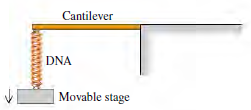Question: During the calibration process, the cantilever is observed to deflect by 0.10 nm when a force of 3.0 pN is applied to it. What deflection
(a) 0.07 nm;
(b) 0.14 nm;
(c) 0.20 nm;
(d) 0.40 nm.
A DNA molecule, with its doublehelix structure, can in some situations behave like a spring. Measuring the force required to stretch single DNA molecules under various conditions can provide information about the biophysical properties of DNA. A technique for measuring the stretching force makes use of a very small cantilever, which consists of a beam that is supported at one end and is free to move at the other end, like a tiny diving board. The cantilever is constructed so that it obeys Hooke€™s law€”that is, the displacement of its free end is proportional to the force applied to it. Because different cantilevers have different force constants, the cantilever€™s response must first be calibrated by applying a known force and determining the resulting deflection of the cantilever. Then one end of a DNA molecule is attached to the free end of the cantilever, and the other end of the DNA molecule is attached to a small stage that can be moved away from the cantilever, stretching the DNA. The stretched DNA pulls on the cantilever, deflecting the end of the cantilever very slightly. The measured deflection is then used to determine the force on the DNA molecule.

Cantilever DNA Movable stage
Step by Step Solution
3.51 Rating (164 Votes )
There are 3 Steps involved in it
IDENTIFY We model the DNA molecule as an ideal spring SET UP Hookes law is ... View full answer

Get step-by-step solutions from verified subject matter experts


